
Knowing the common weeds in Hawaii and how to eliminate them is essential for keeping a clean and healthy lawn and garden in The Aloha State.
There are over 150 plant species considered invasive across the islands of Hawaii. They are vines, flowering plants, shrubs, and trees. Some bear edible fruits, some are uniquely beautiful, and some are highly useful against winds and erosion. But all are aggressive, a danger to native vegetation, and best kept under control.
We selected the most common weeds to watch for and keep at bay from your property, garden, and lawn.
Note: Most noxious weeds have deep roots, propagate from stems, or have prickles and thorns. Consider contacting a professional lawn care service to remove them safely and without regrowth.
- 1. African Tulip Tree (Spathodea campanulata)
- 2. Autograph Tree (Clusia rosea)
- 3. Brazilian Peppertree (Schinus terebinthifolius)
- 4. Common Melastoma (Melastoma candidum)
- 5. Fireweed (Senecio madagascariensis)
- 6. Formosan Koa (Acacia confusa)
- 7. Guinea Grass (Megathyrsus maximus)
- 8. Hilahila (Mimosa pudica L.)
- 9. Hilo Grass (Paspalum conjugatum)
- 10. Indian Fleabane (Pluchea indica)
- 11. Ironwood (Casuarina equisetifolia)
- 12. Ivy Gourd (Coccinia grandis)
- 13. Juniper Berry (Citharexylum caudatum)
- 14. Koa Haole (Leucaena leucocephala)
- 15. Koster’s Curse (Clidemia hirta)
- 16. Maile Pilau (Paederia foetida)
- 17. Octopus Tree (Schefflera actinophylla)
- 18. Paperbark (Melaleuca quinquenervia)
- 19. Red Mangrove (Rhizophora mangle)
- 20. Russian Thistle (Salsola kali)
- 21. Shoebutton Ardisia (Ardisia eliptica)
- 22. Wedelia (Sphagneticola trilobata)
- 23. Yellow Himalayan Raspberry (Rubus ellipticus var. obcordatus)
- FAQ About Hawaii’s Weeds
- Keep Nasty Weeds Under Control
1. African Tulip Tree (Spathodea campanulata)
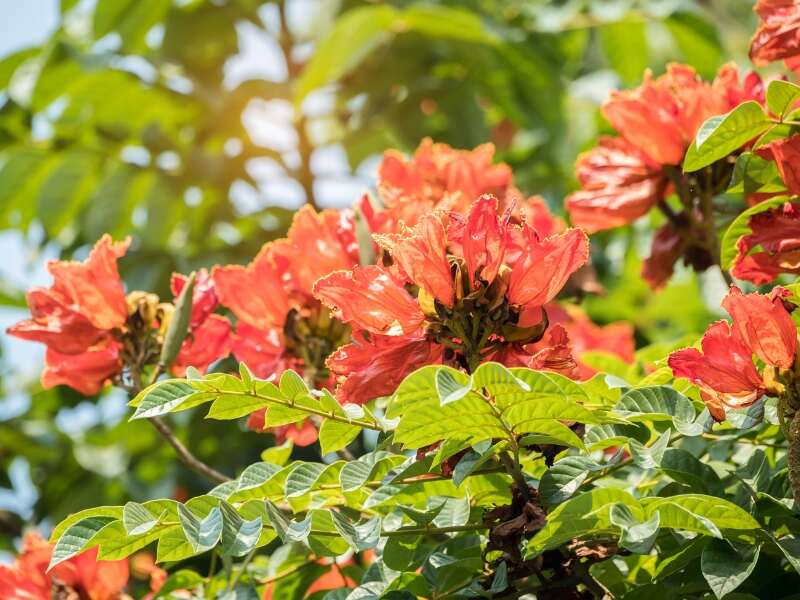
Introduced to Hawaii in the 1900s for reforestation purposes, the African tulip is today a menace to the native vegetation and wildlife. It invades forests and pastures, and its blooms are toxic for local pollinators.
While attractive for its foliage and large, orange, tulip-like flowers, it is not a tree to invite in your garden. It grows brittle branches that can break easily in the wind and roots that can damage sidewalks and walkways.
- Other common names: African tulip tree, panchot, flame of the forest, fountain tree, fire tree, fire bell, Nandi flame, Gabon tulip tree, syringe tree, pancut-pancut.
- Type: Evergreen tree
- How to identify: It blooms year-round with scarlet-orange tulip-shaped flowers in large clusters.
- How to get rid of African tulip tree: Treat with dicamba or glyphosate in cut-surface applications.
Shop herbicides with glyphosate online:
2. Autograph Tree (Clusia rosea)
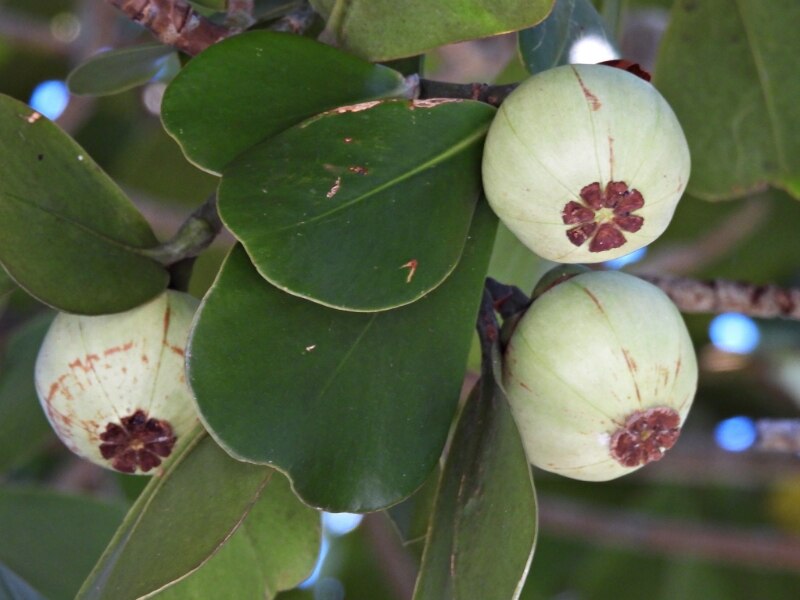
Imported in 1934 for its beauty and medicinal properties, the autograph tree is deemed today one of Hawaii’s most invasive horticultural plants. On Maui, it’s densely distributed in the lowland urban areas of Kahului, Lahaina, Kihei, Makawao, Haiku, and Hana.
This noxious tree often escapes cultivation because of its productive seeding. When it does, it acts like a parasite or, in this case, an epiphyte. Its seeds set and germinate on native host trees. Seedlings dry out the hosts of moisture and nutrients and eventually kill them before rooting into the soil.
- Other common names: Copey, Florida clusia
- Type: Hemiepiphyte tree (it can grow on the ground or as an epiphytic strangler in a host tree).
- How to identify:
— Its leaves are thick, waxy, deep green, and tear-shaped. If you carve letters on them, the writing remains even after the leaves grow.
— The blooms are cup-like pink flowers that only last half a day. - How to get rid of autograph tree:
— You can hand-pull or cut young trees, but be careful–the sap is poisonous.
— Older trees are harder to remove due to their extensive root system. It’s better to hire an arborist to do this.
— Another way to control this weed in your garden is to use herbicides. The autograph tree is sensitive to triclopyr.
3. Brazilian Peppertree (Schinus terebinthifolius)
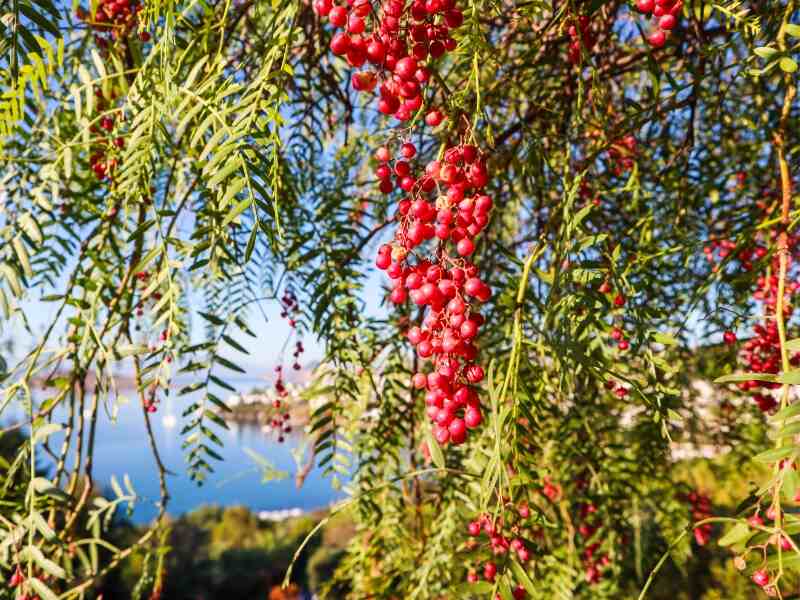
Bearing bright red berry fruits that make you think of mistletoe and Christmas carols, the Brazilian peppertree looks charming and fun. But as it turns out, it doesn’t play so well with others.
A noxious weed in Hawaii, it invades shaded forests and sunny lowlands alike, threatening the existence of local vegetation. In infested areas, Brazilian peppertree forms dense, impenetrable stands with its horizontal branches. It’s also an allelopathic plant, releasing chemicals into the soil that prevent other plants from growing.
- Other common names: Christmas berry tree, Christmas berry, Brazilian pepper
- Type: Perennial evergreen tree or shrub.
- How to identify:
— It has a short trunk with horizontal branches.
— Brazilian pepper blooms clusters of small white flowers that seem yellow or light green from a distance.
— If crushed, its leaves smell like a mixture of pepper and resin. - How to get rid of Brazilian peppertree:
— Make cut-stump or basal-bark applications with triclopyr on mature trees.
— Foliar applications with triclopyr or glyphosate are effective only on seedlings and saplings.
Note: Some triclopyr products may be classified as Restricted Use Pesticides (RUPs). Hire a licensed applicator to treat the weed with this type of product.
4. Common Melastoma (Melastoma candidum)
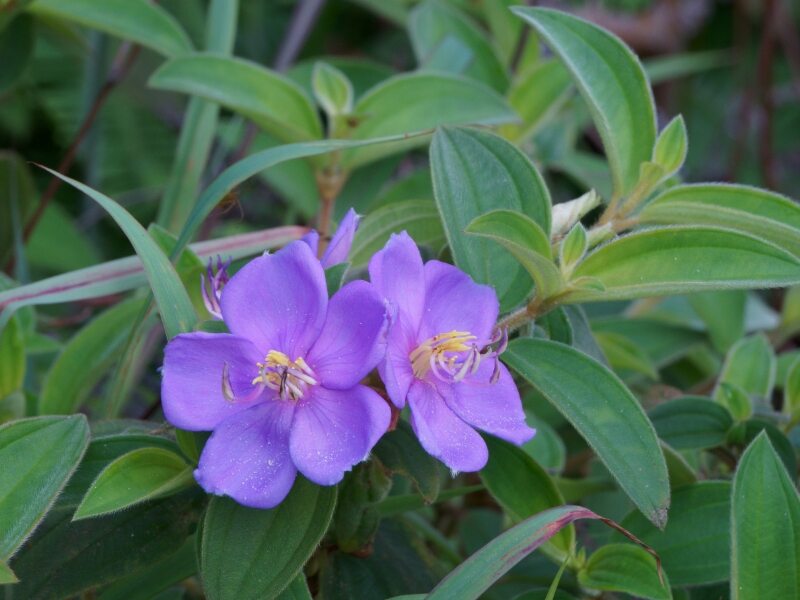
Common melastoma arrived in Kauai in 1916 from Florida as an ornamental but made a name for itself as an invasive weed.
It grows up to 15 feet tall, spreads fast, and forms dense, impenetrable thickets. Its dense canopy shades out the native understory and can bleach entire areas if left unchecked.
- Other common names: Asian melastoma, bluetongue
- Type: Evergreen shrub; Broadleaf
- How to identify:
— Pink to lavender or purple flowers with 5 petals.
— Ovoid leaves with a pointed tip and five longitudinal, prominent arching veins. - How to get rid of common melastoma: It’s sensitive to 2,4-D, dicamba, triclopyr, and metsulfuron.
5. Fireweed (Senecio madagascariensis)
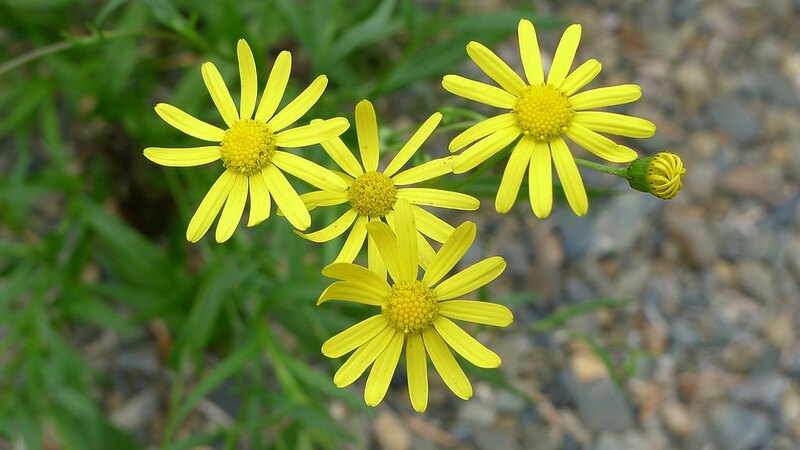
Fireweed is a common lawn weed to watch out for in Hawaii, crowding warm and cool-season grasses alike. It’s widespread on Maui, Oahu, Lanai, and the Big Island, where it thrives in grasslands, abandoned pastures, and roadsides.
Besides making your turf look bad, this noxious weed is a real menace for livestock. If ingested by cattle, horses, and other animals, it causes illness, slowing growth. It can lead to liver malfunction and even death.
- Other common names: Madagascar ragwort, firewood
- Type: Annual or biannual herb
- How to identify:
— It’s an upright herb with bright green, narrow leaves, only ¼” wide and about 5” long.
— It blooms small yellow flowers with 13 petals. - How to get rid of fireweed: Manually remove or treat weeds with pesticides before blooming (2,4D, bromoxynil, and triclopyr are good options).
Shop weed removal tools online:
6. Formosan Koa (Acacia confusa)
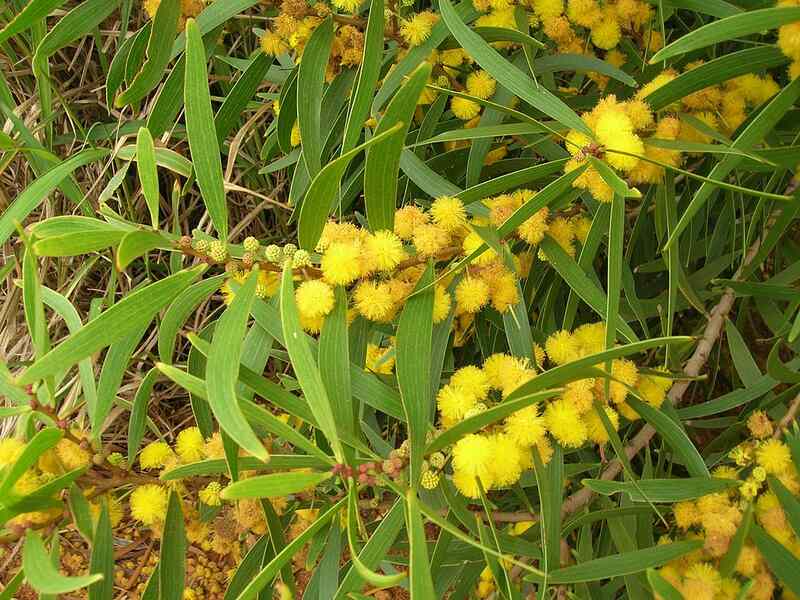
Native to Taiwan and the Philippines, koa traveled to Hawaii in the early 1900s to help with soil stabilization. It enjoyed the climate so much that it naturalized on all the main islands.
Acacia grows a tall tree, up to 50 feet in height, and eliminates desirable groundcovers. It also shades out the understory, forming monotype stands in forests and pastures. All its parts are toxic, and seeds can take over quickly in any area, so avoid bringing them into your outdoor space.
- Other common names: Small Philippine acacia, Yanagi, acacia petit feuille
- Type: Evergreen tree
- How to identify:
— It has a compacted round crown and blooms small, ball-shaped, puff-like, bright yellow flowers.
— Don’t confuse it with the native Acacia koa or Acacia koaia with white to pale yellow flowers. - How to get rid of Acacia confusa:
— Hand-pull young shoots.
— Call a tree care service to remove mature trees.
7. Guinea Grass (Megathyrsus maximus)
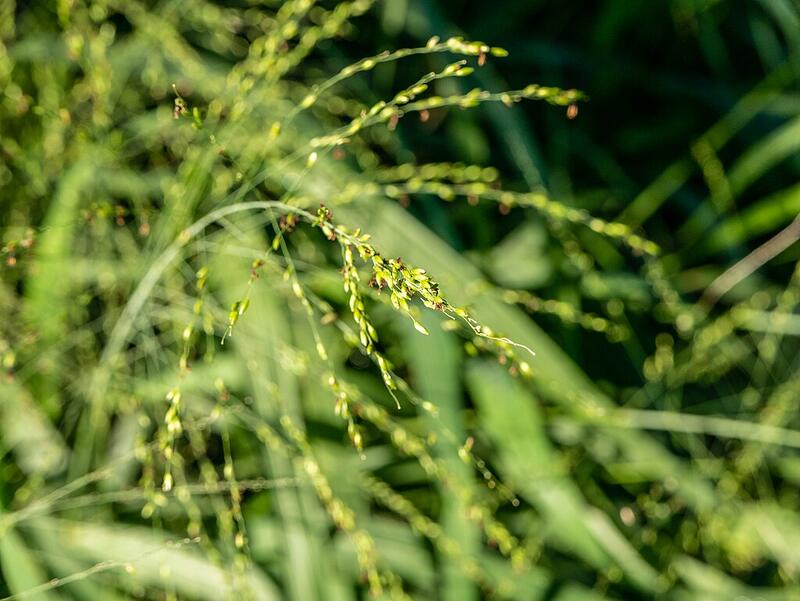
Previously known as Panicum maximum and Urochloa maxima, Guinea grass is a robust perennial planted for forage. It spreads fast by seed and can easily land in your backyard. And that’s not all the bad news.
Guinea grass is an aggressive, fast grower. It forms dense stands that can suppress or displace native plants and your neat turf.
Widely planted at lower altitudes across the islands, this tufted grass is also a known fire hazard. During drought, it forms large masses of dry material that sustain fire and help it travel fast over large distances.
- Other common names: Green panic grass
- Type: Perennial grass
- How to identify:
— Tufted grass, growing in bunches 3 to 7 feet tall.
— It has stout, flattened stems and large leaves 10 to 30 inches long and ½ to 1 inch wide. - How to get rid of Guinea grass:
— Hand-pull if in small numbers.
— Use herbicides for large areas. It is sensitive to glyphosate, and many selective herbicides can kill young plants.
8. Hilahila (Mimosa pudica L.)
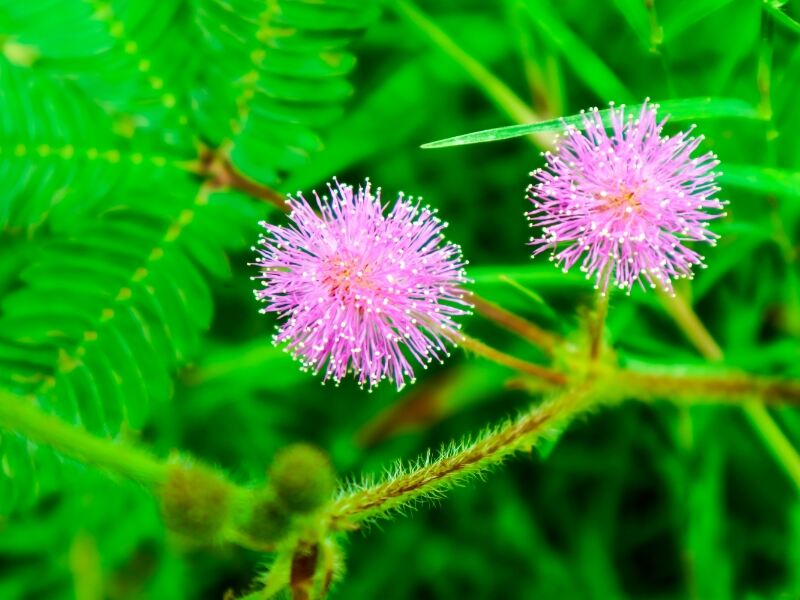
A low-growing creeping herb, hilahila invades lawns, landscaping, crops, and forests. It’s amazingly prolific – one plant growing in your yard can spread up to 700 seeds yearly.
It likes the shade and feels comfortable spreading under shrubs and trees. The prickles make barefooting in Hawaiian lawns challenging, but the most serious risk is the fire hazard it represents when dry.
- Other common names: Sensitive plant, sleeping grass
- Type: Annual woody herb
- How to identify:
— It has red stems and feathery double-compound leaves with up to 26 leaflets.
— Leaves fold when touched, mimicking wilting. - How to get rid of hilahila:
— Prickles make pulling out the plants difficult.
— Hilahila is sensitive to picloram and triclopyr-based herbicides.
9. Hilo Grass (Paspalum conjugatum)
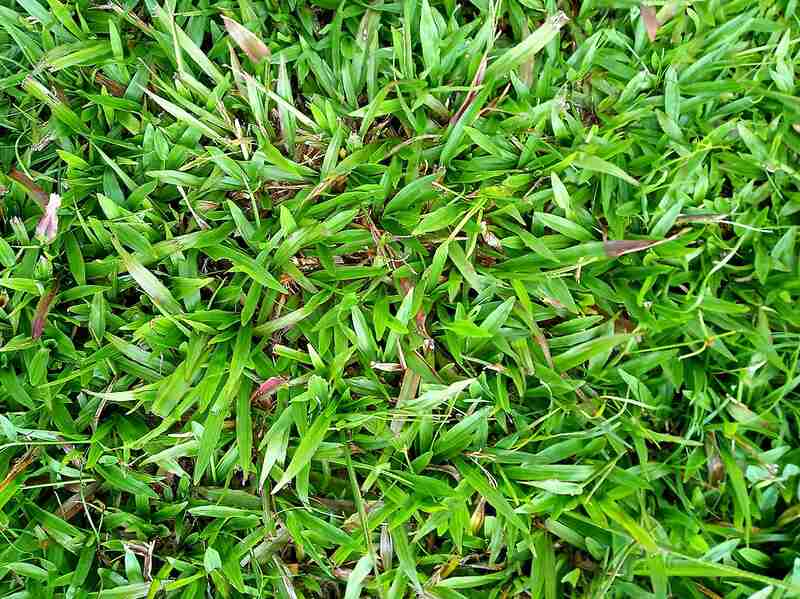
Hilo grass, or mau‘u Hilo, as native Hawaiians call it, is an invasive grass-like plant that can easily smother other grasses and tree seedlings. It can ruin pastures, lawns, gardens, orchards, and vineyards and doesn’t mind poor soil or acidic pH.
Hilo grass grows in open places in forests, moist grasslands, and shrublands along streams, riverbanks, and ditches. Seeds are easy to travel on livestock and clothing and can spread far from the infested areas.
- Other common names: T grass, sour grass, sour paspalum, carabo grass, Johnston River grass, cow grass, Thurston grass
- Type: Short creeping grasslike perennial
- How to identify:
— Grass-like leaves, similar to turfgrass, but grown alternatively on the stem.
— Its yellowish inflorescence is a dead giveaway: two horizontal stems on a tall, thin stalk making the shape of the letter “T”. - How to get rid of Hilo grass:
— It’s sensitive to glyphosate, imazapyr, MSMA, DSMA, dicamba, bromacil, paraquat, metsulfuron, amitrole.
10. Indian Fleabane (Pluchea indica)
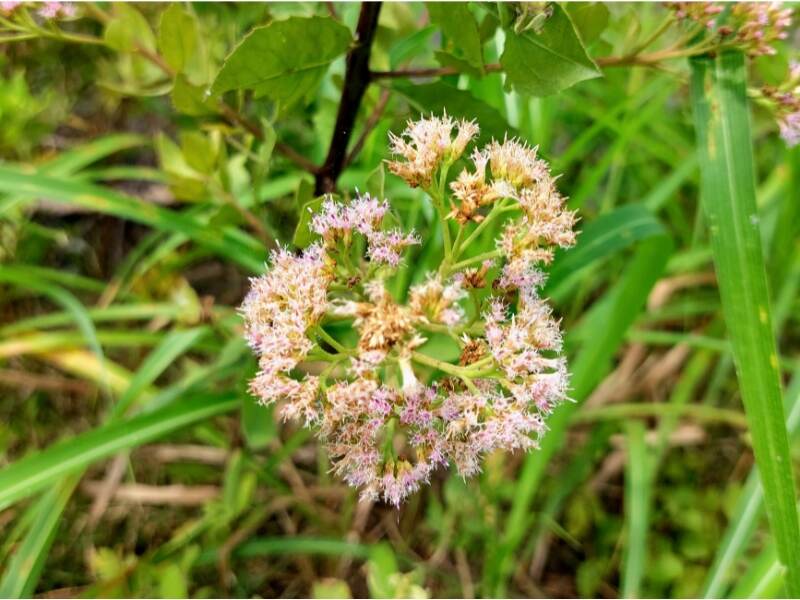
This invasive shrub is native to Asia and was first collected in Oahu in 1915. It displaces native plants in marshes and pastures along the coast. Indian fleabane also changes and destroys the habitat of water birds, negatively impacting local wildlife.
- Other common names: Indian pluchea, sweet scent, shrubby camphor weed, sourbush, purple pulchea, stinkweed
- Type: Short-lived perennial herb
- How to identify:
— It’s a medium size shrub, up to 6 feet tall, with dentate leaves.
— Indian fleabane blooms spherical flowers in shades of pink and lavender. - How to get rid of Indian fleabane: Hand-pull or treat with 2,4-D or glyphosate.
11. Ironwood (Casuarina equisetifolia)
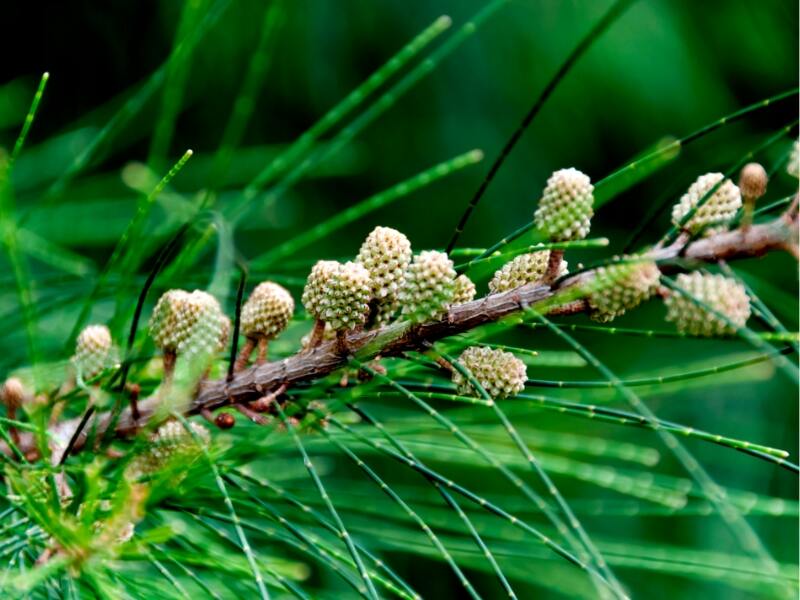
Here’s a tree used for windbreaks along the Kohala Mountain Road in Hawaii, at Waimanalo and Hanalei, that can be a common noxious weed in your yard. Its exotic look, coupled with excellent salt, sand, and wind tolerance, makes it attractive for coastal landscaping. But it’s mostly a trap.
Ironwood changes the habitat it grows in, but not in a good way:
— It offers no wildlife habitat (except for the goldfinches eating its seeds).
— It outcompetes native trees and shrubs.
— The roots ruin pavement, water lines, and sewers and contribute to soil erosion.
— Its pollen is highly allergenic.
- Other common names: Australian pine, horsetail casuarina, shortleaf ironwood, beefwood, she-oak
- Type: Deciduous tree
- How to identify:
— It has needle-like foliage similar to pines.
— It grows slender, drooping branches and woody cones less than 1 inch long. - How to get rid of ironwood: Treat shoots with foliar triclopyr and mature trees with glyphosate, dicamba, and picloram in cut-surface applications.
12. Ivy Gourd (Coccinia grandis)
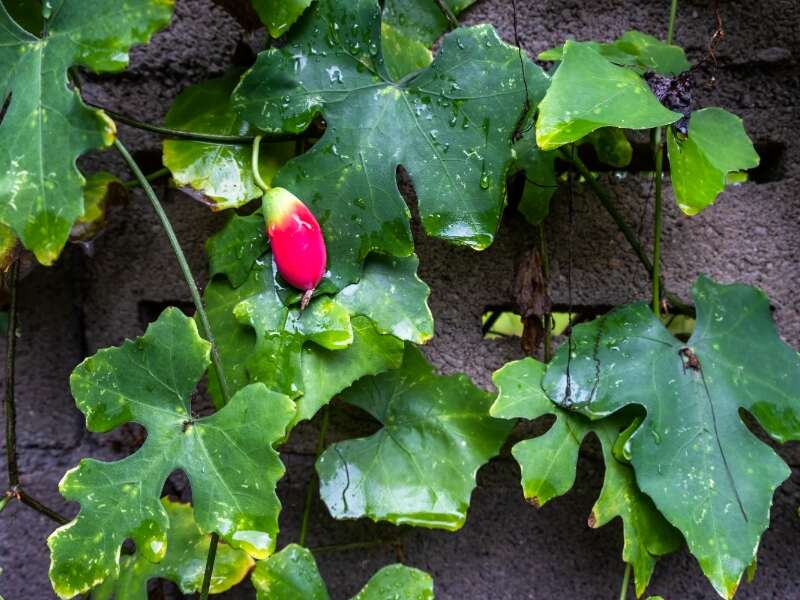
The ivy gourd is an imported invasive vine that grows over ground covers, climbing on shrubs, trees, and vegetables. It smothers the plants and can damage fences and power lines.
Coccinia grandis is hard to deter since it regrows from deep roots, even after herbicide treatment. Naturalized in Lanai, Hawaii, Oahu, and Maui, it is listed on the Hawaii State Noxious Weed List.
- Other common names: Scarlet gourd, tindora, kowai fruit
- Type: Perennial vine
- How to identify:
— It blooms white or yellow star-shaped flowers with 5 petals.
— The fruits resemble cucumbers, and the leaves are ivy-shaped. - How to get rid of ivy gourd:
— Only remove the fruits to destroy the seeds. Hand-pulling the plant seems to help it spread, forcing underground roots to vegetate new shoots.
— Make cut-stump or foliar applications with triclopyr or triclopyr and picloram.
13. Juniper Berry (Citharexylum caudatum)
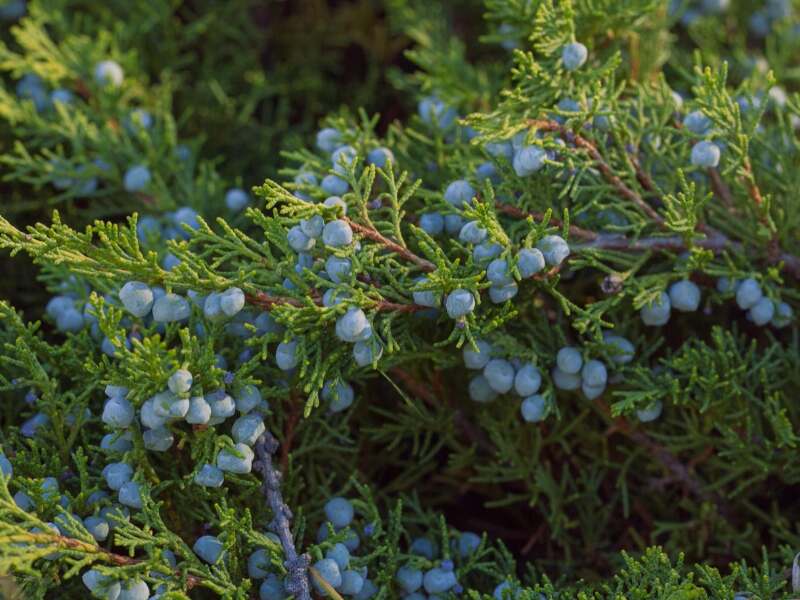
Introduced in 1931 as an ornamental, the juniper berry first escaped from the Lyon Arboretum into the forests of Oahu. It went over into Kauai and Maui and now also has a large presence in the Pepe‘ekeo area in Hawaii.
This fast grower permanently pushes back the native vegetation. It thrives in moist and wet areas, smothering turf, ground covers, shrubs, and flowering plants with its dense, large canopy. Don’t let it set roots in your garden.
- Other common names: Fiddlewood
- Type: Evergreen perennial shrub or tree
- How to identify: It bears small orange berries in elongated clusters.
- How to get rid of juniper berry:
— Pull out the shoots and small shrubs.
— Cut larger shrubs and trees near the plant’s root, and apply herbicide.
14. Koa Haole (Leucaena leucocephala)
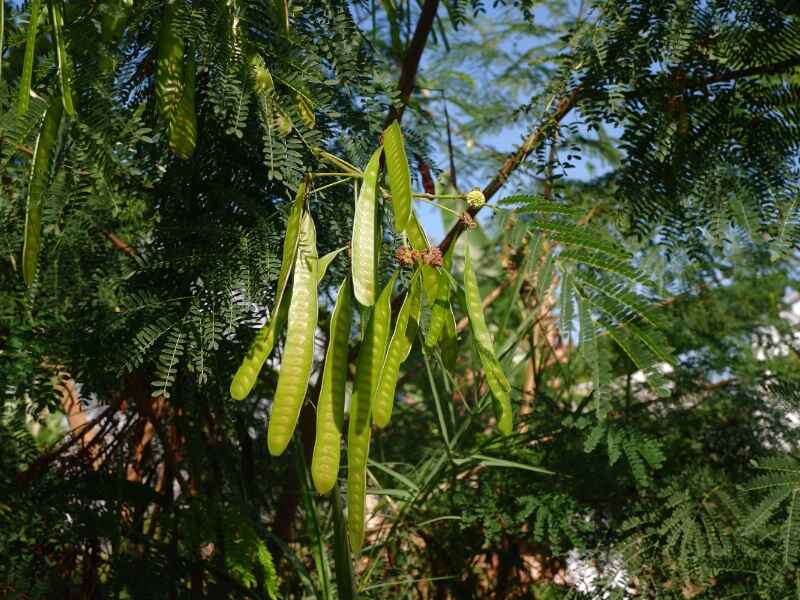
Initially brought on the islands as forage to feed cattle, the koa haole proved more resilient and invasive than expected. It spreads hundreds of seeds and regrows from its roots if cut or injured, making it almost indestructible.
Koa haole forms dense thickets in Hawaii’s dry lowlands and lower mountain slopes. It grows as a shrub or tree and contains mimosine, a toxic alkaloid that can cause illness in some animals.
- Other common names: False koa, lili-koa, ekoa, wild tamarind
- Type: Deciduous shrub or tree
- How to identify:
— It has large feathery-like leaves, twice-pinnate, with numerous small gray-green leaflets.
— The koa haole blooms white, round ball-like flowers that turn into brown, large pod clusters. - How to get rid of koa haole:
— Manually remove shoots and young shrubs by hand or with gardening tools.
— It’s sensitive to triclopyr (foliar application), tebuthiuron (soil application), and picloram (cut-surface application).
15. Koster’s Curse (Clidemia hirta)
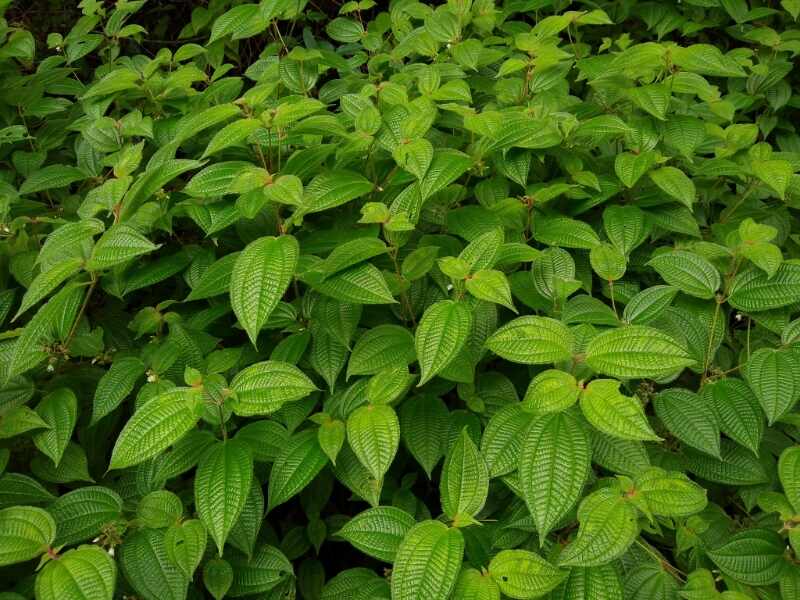
Koster’s curse is a shade-tolerant branching shrub growing up to 9 feet tall. It loves moderately wet areas and dominates the understory in forests around Kauai, Oahu, Molokai, Maui, and Hawaii.
Clidemia hirta spreads fast through seeds and has a fast growth rate. If you let it have its way in your garden, it grows in dense, impenetrable thickets that suppress other plants.
- Other common names: Clidemia, soapbush
- Type: Perennial shrub
- How to identify:
— Vine-like stems covered in coarse red bristles.
— Its leaves have a unique “leaf-within-a-leaf” pattern with five prominent longitudinal and horizontal veins. Don’t confuse it with Miconia calvensis, another weed with a similar appearance but larger leaves. - How to get rid of Koster’s curse: Pull out seedlings, dig out shrubs, and apply herbicides like triclopyr and glyphosate.
16. Maile Pilau (Paederia foetida)
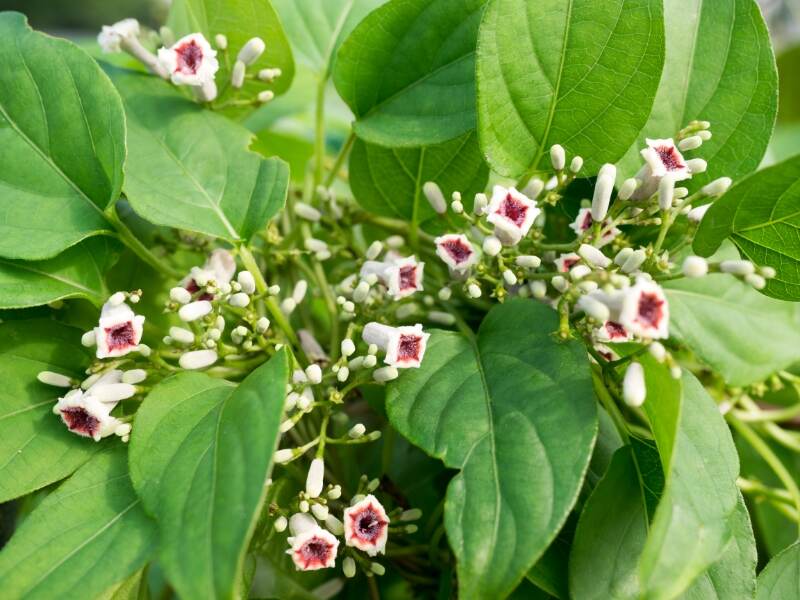
Able to grow up to 30 feet in length, maile pilau climbs over vegetation and structures, covering shrubs and trees with its glossy foliage and tough stems. It steals their light and nutrients, breaks branches under its weight, and interferes with utilities and power lines.
Native to Eastern Asia, this vine or shrub is locally common on Maui, Hawaii Island, Oahu, and Kauai and is also considered among the invasive plants in Florida and other parts of the USA. It tolerates a wide range of soils, salt spray, and shade, and it’s difficult to combat once established.
- Other common names: Stink maile, stink vine, skunk vine
- Type: Perennial evergreen vine or shrub
- How to identify:
— It has oval, glossy, waxy leaves that release a stinky smell when crushed.
— Maile pilau blooms tubular flowers covered in white wooly hairs at the exterior and purple inside. - How to get rid of maile pilau:
— Hand-pull young plants, but ensure you collect all fragments of stems since they can lay down roots.
— Maile pilau is sensitive to triclopyr-based herbicides.
17. Octopus Tree (Schefflera actinophylla)
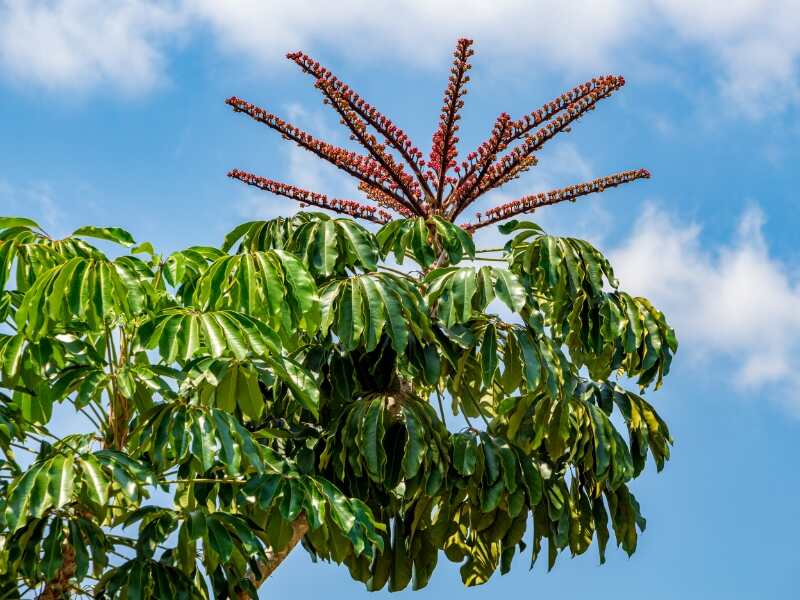
Naturalized in Hawaii before 1900, the octopus tree is an aggressive, stubborn species. It spreads easily through seeds into the local forests, putting the native trees in danger.
The octopus tree grows on the ground and as an epiphyte, often killing the host trees. It also harms other plants through its dense shade. The roots are another disturbing issue for its urban presence. A 1-inch diameter octopus tree root can lift a sidewalk or damage a home’s foundation.
- Other common names: Umbrella tree, ivy palm
- Type: Hemiepiphyte tree (it can grow on the ground or as an epiphytic strangler on a host tree)
- How to identify:
— It has compound palm-like leaves that resemble an umbrella. Radial floral branches seem to turn into tentacles when bearing tiny, round fruits. - How to get rid of octopus tree:
— Eradicate young trees by cutting or applying herbicide before they start seeding.
— Basal bark or cut-stump triclopyr applications are recommended options for mature trees.
18. Paperbark (Melaleuca quinquenervia)
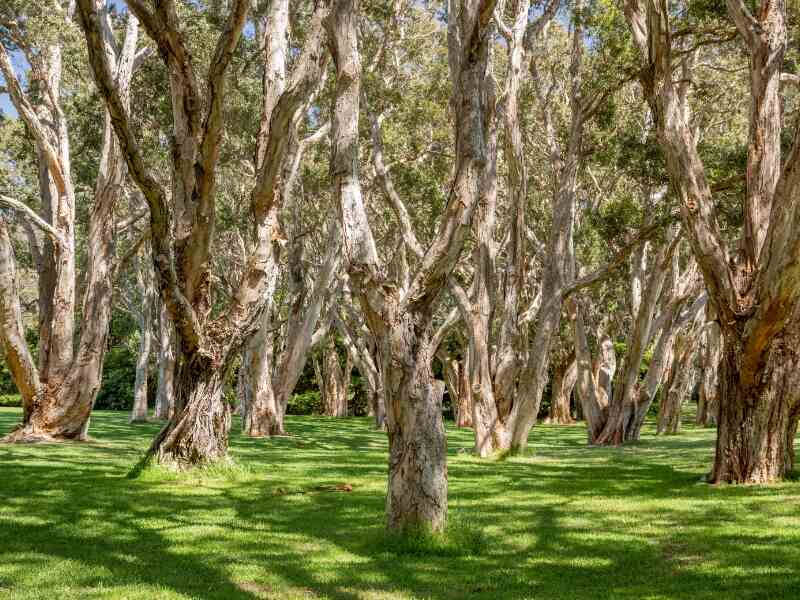
Growing up to 75 feet tall, paperbark was brought to Hawaii to create windbreaks and reforest degraded and flooded areas. It’s treasured for its gray bark that shreds in paper-thin ornamental layers.
But it is an invasive weed. The Division of Forestry and Wildlife of the Hawaii Department of Land and Natural Resources considers it one of Hawaii’s most invasive horticultural plants.
The tree is highly flammable. Its pollen is irritative, and it’s also an allelopathic plant, releasing chemicals that prevent the development of other species.
- Other common names: Cajeput tree
- Type: Evergreen ornamental and forest tree
- How to identify: Tall tree with spongy gray to tan bark that peels in paper-like layers.
- How to get rid of paperbark: It’s sensitive to imazapyr in cut-stump applications and to glyphosate, dicamba, and triclopyr applied in drilled holes.
19. Red Mangrove (Rhizophora mangle)

Native to Florida, the Caribbean, and South America, the red mangrove was brought to Hawaii in 1902 to stabilize mud flats along Molokai’s southwest shore. Red mangroves have huge prop roots that trap tide sediment, building soil around them.
They did the job but became invasive and hard to control. To Hawaii, they are aliens. Imported trees change the coastal ecology and attract exotic wildlife to the detriment of the local animals, such as the endangered Hawaiian stilt.
- Other common names: American mangrove
- Type: Broad-leaved evergreen tree
- How to identify: It grows up to 30 feet tall and is easy to identify due to its remarkable aboveground prop roots.
- How to get rid of red mangroves:
— Red mangroves are difficult to remove because few herbicides are safe for the marine environment.
— Mechanical topping (removing the top of the tree manually) below the low tide water line is a good option – but you’ll likely need to call a professional tree care service for this.
20. Russian Thistle (Salsola kali)
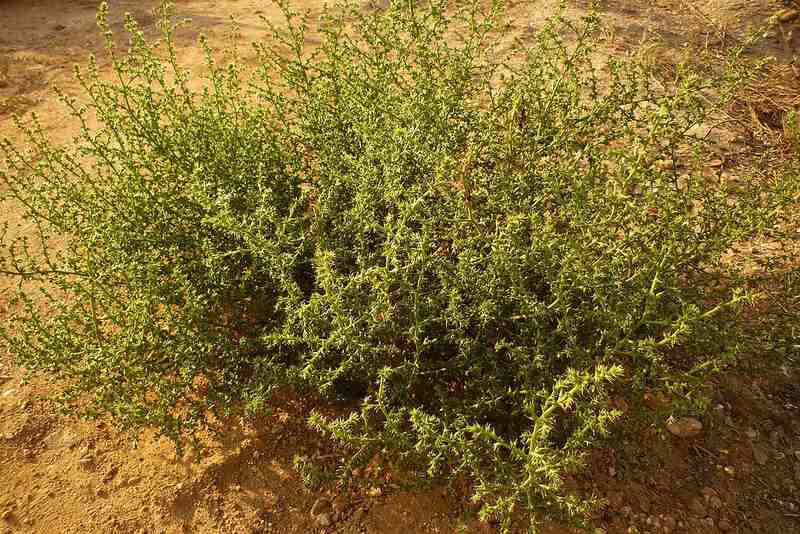
Remember that dry bush tumbling across a desolate desert highway in Hollywood movies? That’s the controversial Russian thistle or Salsola kali. Edible for humans and forage for many animals, this spiny shrub can also help damaged soil recover faster and bear new vegetation.
So, why is it so dreaded? Salsola kali is very invasive. Mature plants break at the soil line and simply fly and tumble across the land, spreading their seeds everywhere. Its free traveling habit is also a fire hazard not to be ignored, considering the recent increase of wildfires across the Pacific islands.
- Other common names: Tumbleweed, wind witch
- Type: Branching shrub
- How to identify: It branches into rounded shrubs with modified leaves, so small and tipped with spines that it seems leafless.
- How to get rid of Russian thistle:
— Cattle graze the plant.
— Fences limit the movement of detached shrubs.
— The Russian thistle is sensitive to dicamba, triclopyr, and 2,4-D.
21. Shoebutton Ardisia (Ardisia eliptica)
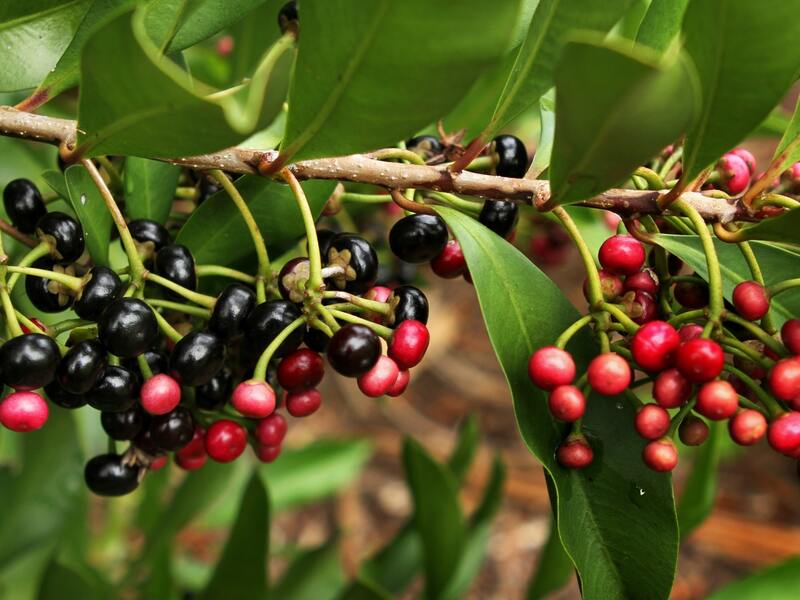
An ornamental shrub native to India and Southeast Asia, the shoebutton ardisia is among the top 100 of the world’s worst invasive alien species listed in the Global Invasive Species Database.
It is naturalized in wet forests and pastures in Maui, Kauai, Oahu, and Hawaii. Thriving in the shade, it can also grow in open spaces. It forms dense stands and suppresses turf, ground covers, and understory.
- Other common names: Duck’s eye, jet berry
- Type: Perennial shrub
- How to identify:
— It grows up to 16 feet tall with oval, elongated leaves, with entire margins, reddish when young.
— It blooms clusters of five-petal flowers, pinkish with tiny black spots on their outer surfaces. - How to remove shoebutton ardisia:
— Pull out shoots by hand or with a gardening tool.
— Cut off mature shrubs, and treat them with 2,4-D to prevent regrowth. Here’s how to spray the herbicides correctly.
22. Wedelia (Sphagneticola trilobata)
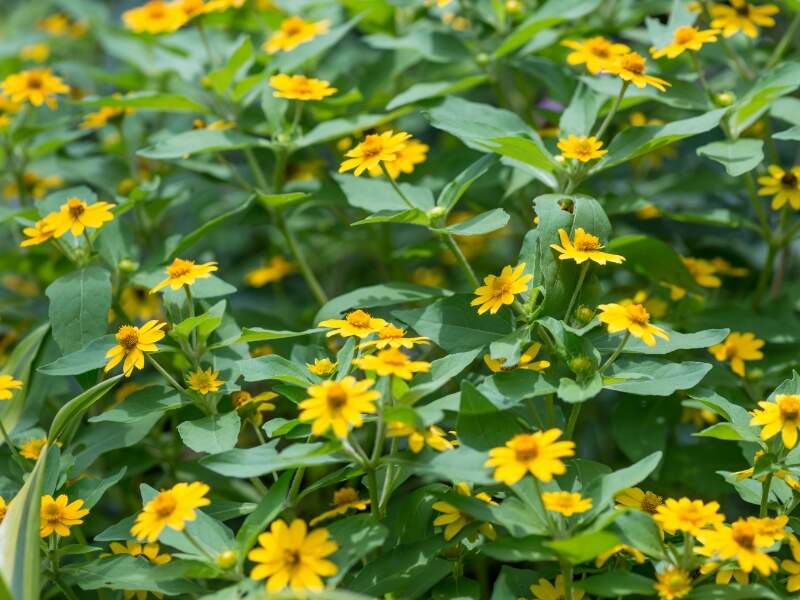
Imported to Hawaii as an ornamental around 1970, wedelia is native to Mexico, Central America, and some Caribbean Islands. It’s a creeping herb that can grow up to 13 feet long, developing roots where stem nodes touch the ground.
The Division of Forestry and Wildlife of the Hawaii Department of Land and Natural Resources included wedelia among Hawaii’s most invasive horticultural plants for its aggressive growth habit. It invades pastures, forests, and lawns and crowds out more desirable low-growing plants. Wedelia is also toxic for animals.
- Other common names: Yellow creeping daisy, Singapore daisy, creeping ox-eye, trailing daisy, rabbit’s paw
- Type: Creeping herb
- How to identify: It’s a matted ground cover with glossy leaves, round stems, and yellow, daisy-like flowers.
- How to get rid of wedelia: It’s sensitive to dicamba and triclopyr.
23. Yellow Himalayan Raspberry (Rubus ellipticus var. obcordatus)
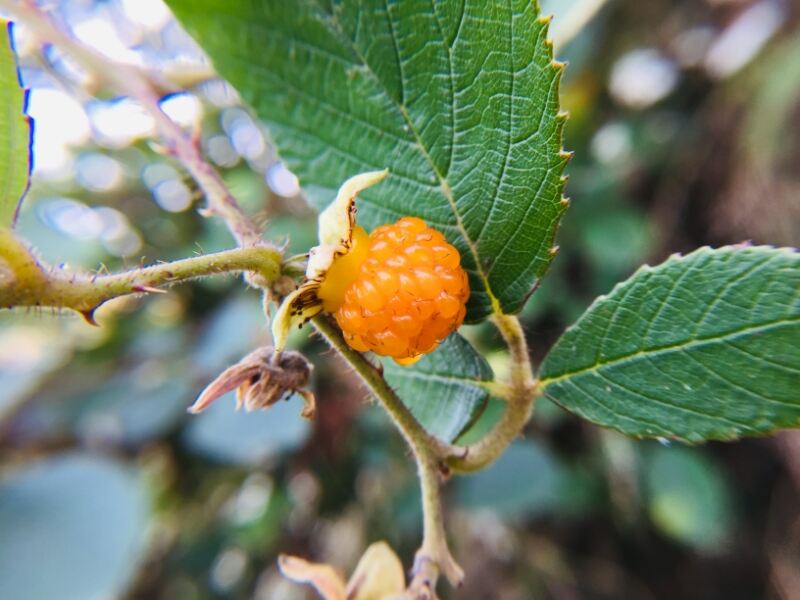
Listed among the world’s 100 most invasive species by the International Union for Conservation of Nature, the yellow Himalayan raspberry was introduced in Hawaii in 1961 as an edible fruit.
It’s a spiny, sprawling bush that can grow up to 15 feet, forming dense stands that exclude native vegetation. It occupies disturbed forests, roadside ditches, pastures, and urban areas. Rubus ellipticus infestations can produce 700-1,300 seeds per square foot.
- Other common names: Golden evergreen raspberry, golden Himalayan raspberry
- Type: Evergreen shrub
- How to identify:
— Its stems are covered in reddish hairs and thorns.
— The leaves are a compound of 3 oval-shaped leaflets.
— It blooms small white flowers with 5 petals, and fruits are yellow drupe. - How to get rid of yellow Himalayan raspberry:
— Pull out the plant, ensuring you remove as much of its root system as possible.
— You can also treat it with Roundup.
Buy Roundup online:
FAQ About Hawaii’s Weeds
You can identify a weed by its:
● Habit of growth – climbing vines, shrubs, trees with horizontal branches, etc
● Leaves – their place on the stems, type (simple or compound), shape, margins, and veins. Some have distinctive features, such as fine hair or a specific smell when crushed.
● Flowers – structure (individual or in clusters), size, shape, color, smell
● Fruits – size, shape, structure, color
● Life cycle – annual, biennial, perennial
Hawaii’s most invasive non-native grasses are pampas, fountain, and guinea grass. They often grow in lawns, competing with the most common types of turfgrass in Hawaii.
Among the plants you can’t bring to Hawaii without treatment, quarantine, certification, or special permit are:
● Pineapple
● Passion fruit
● Cruciferous root vegetables (radish, turnip, daikon, horseradish, rutabaga)
● Citrus and pulpy fruits from Florida & Puerto Rico
● Taro and dasheen
● Coconuts
● Orchid plants
● Plants in the grass family (including sugar cane and bamboo)
● Coffee plants
● Palm plants
● Aster, chrysanthemum, hollyhock, dahlia, and gladiolus plants
● Pine plants
● Sorghum, broomcorn, and Sudan grass
If you want to replace turf with low-maintenance ground covers, pauohiaka, hinahina, nanea, aeae, golden glory, and red ivy are the best options for Hawaiian landscapes.
To successfully remove weeds in grass, follow these easy steps:
● Identify the type of weed.
● Choose a proper herbicide.
● Spread the weed killer on a day with temperatures between 45 and 90°F.
● Treat all weeds in and around the lawn.
● Watch for weeds that try to regrow and hand-pull all of them.
Following proper lawn care techniques to keep your turfgrass healthy and thick is the best way to prevent weeds in the first place. See our article on how to grow grass in Hawaii for local lawn maintenance tips.
Keep Nasty Weeds Under Control
Weeds can make it difficult to keep a clean, healthy lawn and garden, and Hawaii is not in shortage of them. Some you can pull out or kill with a common herbicide. Others are much harder to get rid of.
If you’re dealing with super stubborn weeds, LawnStarter connects you to lawn care pros near you. Whether you’re living in Honolulu or anywhere else in the archipelago, LawnStarter can help you find an expert who can control even the nastiest weeds.
Main Photo Credit: Margaux Omhover / Canva Pro / License
LawnStarter participates in the Amazon Services LLC Associates Program, an affiliate advertising program. LawnStarter may earn revenue from products promoted in this article.